Posted by James (admin) on 14th September 2012
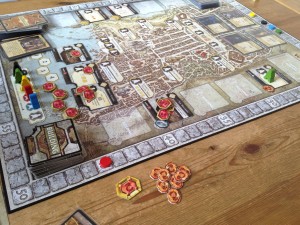 I wasn’t expecting much when Lords of Waterdeep was announced as Dungeons and Dragons-based board games have been pretty lack lustre in the past (the drab Castle Ravenloft being one). However, Lords of Waterdeep is very good with more of a eurogame at its heart.
I wasn’t expecting much when Lords of Waterdeep was announced as Dungeons and Dragons-based board games have been pretty lack lustre in the past (the drab Castle Ravenloft being one). However, Lords of Waterdeep is very good with more of a eurogame at its heart.
During the game, players try to earn as many points as possible by completing their quests. Each quest is completed by sending (spending) the number of adventurers (clerics, rogues, fighters and wizards) shown on the quest, and some quests give the player a special ability too. The main game mechanic is a worker placement game and, on their turn, a player places one of their agents (workers) onto the board and uses the benefit of that location. Locations can give the player adventurers, money, allow them to take a new quest from those on display, build a building (paying resources to do so), etc. One interesting location is the harbour which not only allows players to play one of the Intrigue card they may hold (which can be very beneficial to the player, or detrimental to opponents), but agents at the harbour also get to be reassigned to any free locations after all the other agents have been placed.
Like any other location, the buildings built by players as an action can be used by any player by placing an agent there as usual (and the owner gets a benefit if another player uses their building). The effects of the 24 buildings are very varied allowing players to do things like add an agent to a location even though it has already been used, etc. Read the rest of this entry »
Tags: board game news, Board Games, board gaming, Lords of Waterdeep
Posted in Board Game Review, Board Games, Lords of Waterdeep | No Comments »
Posted by James (admin) on 13th September 2012
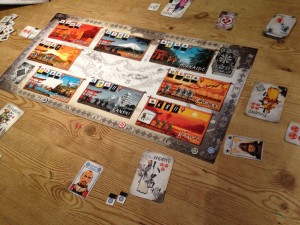 Shitenno is designed by Cédric Lefebvre whose previous games (Yggdrasil and Offrandes) have been really good. Shitenno is a game set in feudal Japan which mixes a you-cut-I-decide mechanic with area control. Each round, 2 troop cards and 1 income card per player are drawn face-up – the first player in turn order is the Tairo who selects any number and mix of the cards and offers them to the other players (in turn order) along with one of the 4 role cards. A player can accept or refuse the offer – if a player accepts, they take the cards and role and can not accept any more cards that round, then the Tairo selects a new mix of cards and a role to offer to the remaining players who have yet to accept an offer that round. If no other player accepts an offer, the Tairo must take the cards and role themselves (and the next player in turn order who has not accepted an offer becomes the Tairo).
Shitenno is designed by Cédric Lefebvre whose previous games (Yggdrasil and Offrandes) have been really good. Shitenno is a game set in feudal Japan which mixes a you-cut-I-decide mechanic with area control. Each round, 2 troop cards and 1 income card per player are drawn face-up – the first player in turn order is the Tairo who selects any number and mix of the cards and offers them to the other players (in turn order) along with one of the 4 role cards. A player can accept or refuse the offer – if a player accepts, they take the cards and role and can not accept any more cards that round, then the Tairo selects a new mix of cards and a role to offer to the remaining players who have yet to accept an offer that round. If no other player accepts an offer, the Tairo must take the cards and role themselves (and the next player in turn order who has not accepted an offer becomes the Tairo).
Once each player has accepted some cards (the final player to accepts all that remains), the players now claim areas in turn order which is dictated by the role cards they received (and the roles also give other special abilities too).
The board has 8 regions and spaces for 4 control markers in each (which I shall call zones). Players get points for placing a control marker in a zone equal to the number printed on the zone – the zones must be claimed in order and players get more points the later they claim a zone in a region. The zones in some regions score more points than others, but these take more cards to claim them. As well as points for claiming zones, players will score extra points at the end of the game if they have the most control markers in a zone (with ties being split by whoever was there earliest). Read the rest of this entry »
Tags: board game news, Board Games, board gaming, Shitenno
Posted in Board Game Review, Board Games, Shitenno | No Comments »
Posted by James (admin) on 12th September 2012
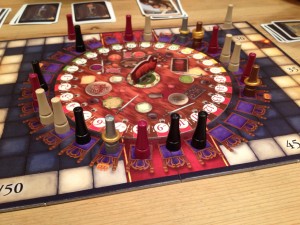 Artus is a game about King Arthur and the round table designed by Michael Kiesling and Wolfgang Kramer (the creators of great games such as Tikal, Tikal II and Asara). The board shows the round table with seats around the outside occupied by players’ knights, the princes and the king. The table shows points values ranging from -15 to +10 for each seat position. The crown on the table always points at the King, so when the King moves, the table turns which means the points for each chair change.
Artus is a game about King Arthur and the round table designed by Michael Kiesling and Wolfgang Kramer (the creators of great games such as Tikal, Tikal II and Asara). The board shows the round table with seats around the outside occupied by players’ knights, the princes and the king. The table shows points values ranging from -15 to +10 for each seat position. The crown on the table always points at the King, so when the King moves, the table turns which means the points for each chair change.
Each player has 22 cards (all will be played during the game) which are split into 3 decks and each player has the same: Knight cards move your own knights, King cards move the King/Princes, and scoring cards. Players start with 3 Knight and 3 King cards, but after their first turn, they can draw cards from any of their decks.
On their turn, players play any 2 of their 6 cards. Knight cards let the player move one of their knights a number of spaces within its range so a 3-6 Knight card lets you move one knight 3, 4, 5 or 6 spaces. Knights move clockwise apart from one card that lets you move one anti-clockwise. When a knight moves, the player scores points equal to the value of the chair (indicated by the table) that they vacate. If a knight moves to a chair already occupied by a knight then that knight gets displaced to the first empty chair anti-clockwise. Read the rest of this entry »
Tags: Artus, Asara, board game news, Board Games, board gaming, Michael Kiesling, Tikal, Tikal II, Wolfgang Kramer
Posted in Artus, Board Game Review, Board Games | No Comments »
Posted by James (admin) on 10th September 2012
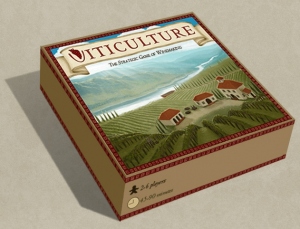 There were a few wine-making games released a couple of years ago and I noticed a new intriguing one called Viticulture on Kickstarter at the moment. The reason it has intrigued me is because it combines several game mechanics that I like in other games.
There were a few wine-making games released a couple of years ago and I noticed a new intriguing one called Viticulture on Kickstarter at the moment. The reason it has intrigued me is because it combines several game mechanics that I like in other games.
During the game players are trying to make the best wineries from their meagre beginnings. Turn order is decided by players claiming different positions and each position gives a benefit – the later the position the better the benefit. This is similar to the turn order system in Fresco (where the best part of the game was deciding what time to get up as that determined turn order as well as other limits like market prices, happiness of workers, etc. for you for that turn). Last Will uses a similar system too.
Viticulture is a worker placement game and mentions Stone Age (one my most favourite games) as an influence too. One interesting aspect is that players perform a rounds worker placement (for the summer actions) resolving the actions as they go, and then perform rounds of worker placement (for the winter actions) with their remaining workers, so workers don’t get returned until the end of the winter actions. There are more action places for more players (so it scales up to 6 players) and, intriguingly, some of the action spaces (for the same action) give better effects so they’re not all quite equal. Actions cover buying vines, harvesting, giving tours (for cash), training new workers, fulfilling wine orders, etc. Read the rest of this entry »
Tags: board game news, Board Games, board gaming, Viticulture
Posted in Board Games, On the Radar, Viticulture | No Comments »
Posted by James (admin) on 7th September 2012
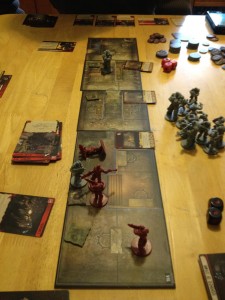 Gears of War is first-person shooter game on Xbox. The board game by Fantasy Flight Games had been listed as in-development for several years so it was interesting to finally get it play it. The video game focusses on a small squad of human soldiers (called COG) fighting against an alien race – a lot of the main action involves frantic gunfights, dashing from (or diving over) cover whilst under (and returning) heavy gunfire, and often throwing grenades into large holes in the ground where the enemies are emerging from.
Gears of War is first-person shooter game on Xbox. The board game by Fantasy Flight Games had been listed as in-development for several years so it was interesting to finally get it play it. The video game focusses on a small squad of human soldiers (called COG) fighting against an alien race – a lot of the main action involves frantic gunfights, dashing from (or diving over) cover whilst under (and returning) heavy gunfire, and often throwing grenades into large holes in the ground where the enemies are emerging from.
The board game of Gears of War has all the players playing the COG soldiers co-operatively against the game (enemy) and there are various scenarios which determine the map, victory conditions, etc. Also, some scenarios have multiple stages and the players must complete one stage before they next is revealed. The map is made of various tile sections and each is divided into several areas which determine movement and weapon range.
Each player has a hand of Order cards (gaining 2 at the start of each turn) which each describe a special action but also act as the player’s health too. Every turn, players play a card to perform the card’s action (like move 4 spaces and attack, revive a comrade, etc.), or to move 2 spaces, or to do 1 standard attack. Each card also has 1 of 3 icons which mean it can be played when it is not the player’s turn to either attack an enemy, gain extra defence dice, or move with a comrade. If a player runs out of cards, they are ‘bleeding out’ until a comrade revives them, which means they can crawl 1 space per turn, don’t get attacked, and gain no cards. Read the rest of this entry »
Tags: board game news, Board Games, board gaming, FFG, Gears of War
Posted in Board Game Review, Board Games, Gears of War | No Comments »
Posted by James (admin) on 6th September 2012
More games to watch out for at Spiel. (I’ve combined all the Spiel games on my radar on my Essen 2012 page.)
Archipelago (Ludically)
This game looks like it has a vast amount of stuff in it – both bits and mechanics. It’s a giant euro game with lots of simple systems but just loads of them, such as tile placement, exploration, an economic system, worker placement for actions, worker placement for area control, semi-co-op, events, evolution cards, and more! Add to that each player has a secret card which states one of the ways that the game will end (it ends as soon as one of these is reached, or it may end with all players losing if rebellion takes hold – yep, there’s rebellion too caused by lack of employment, too many taxes, etc.), plus each player’s card shows one of the ways final scoring will earn points. The core driver of the game though is the worker (discs) placement system to claim the mostly-limited actions each turn. Oh, and the game has three different lengths that you can choose from. Definitely looking forwards to this one.
More info on the Ludically site here: bga.me/archipelago
Robinson Crusoe (Portal)
This sounds like an interesting game with players on a desert island. It’s by the designer of Stronghold so that gets my attention already. Sounds like a good theme and it’s a co-op game which apparently has a decent AI. Not many details yet but the designer has just posted a link to an introductory video on their web site which talks about the main elements of gaining food, building a shelter and tools, and exploring the islands and its mysteries (but no details on gameplay mechanics yet).
More info on the Portal web site: bga.me/crusoe
I’m The Boss: The Card Game (Gryphon)
I still have my copy of the original game by Sid Sackson and it’s a great negotiation game if you like humorous screwage. I’m looking forward to finding out how the card game plays – I don’t think there was ever any real reason for a board in the original that cards couldn’t have provided just as easily; however, a brief look at the rules makes it sound like it’s played quite differently to the original boardgame.
More details and full rules on Gryphon’s Kickstarter page: bga.me/imtheboss
Tags: Archipelago, board game news, Board Games, board gaming, Essen, I'm The Boss, Robinson Crusoe, Spiel 2012
Posted in Archipelago, Board Games, Essen Spiel 12, I'm The Boss, On the Radar, Robinson Crusoe | No Comments »
Posted by James (admin) on 4th September 2012
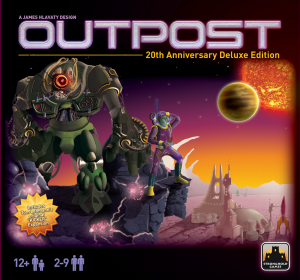 Outpost is a futuristic economic game set in space which is richer than it may first sound. The game ends as soon as one player has gained 75 victory points (VPs) or more, and the winner is player with the most VPs at the end of that round.
Outpost is a futuristic economic game set in space which is richer than it may first sound. The game ends as soon as one player has gained 75 victory points (VPs) or more, and the winner is player with the most VPs at the end of that round.
Player start with some ore mining facilities and a few human colonists to run them. During the game, players will build new (and usually better) production facilities and will gain technologies and more colonists too. The golden rule is (apart from one exception) if you don’t have colonists (or robots) to run a production facility, it is not ‘manned’ so does not produce anything and is worth 0 VPs. Each player has their own player board which shows their current VPs, maximum number of human colonists, and the maximum hand size (cards).
At the start of each round, players draw income cards – one for each staffed production facility. There are different decks for each type of facility and the cards say how many credits of income they have generated. For example, the Ore Mining cards are the least valuable with an average value of 3 credits; whereas, the next better facility is Water Production whose cards are worth an average of 7 credits each. (The best facility’s cards have an average value of 5o credits!) However, the better facilities cost more to build, and many have restrictions and/or require technologies too. This is a nice game mechanic as you know roughly what income you’ll get, but there’s still some randomness too. Read the rest of this entry »
Tags: board game news, Board Games, board gaming, Outpost
Posted in Board Game Review, Board Games, Outpost | No Comments »
Posted by James (admin) on 3rd September 2012
More games to watch out for at Spiel. (I’ve combined all the Spiel games on my radar on my Essen 2012 page.)
Phantom (Ludonaute)
A 2-player game announced today by Ludonaute who say some people call Phantom a mixture of ‘Lost Cities’ with elements of ‘Magic: The Gathering’. That’s a lot to live up to and I really hope it does as there have been few great 2-player games in recent years. The game has players playing two restless ghosts in a house trying to scare the current occupants more than the other player by creating apparitions in the 4 areas of the house. It sounds really interesting.
Check out the details and rules at Ludonaute’s web site: bga.me/phantom
La Loire (Emanuele Ornella)
I like Emanuele Ornella’s games (Il Principe, Charon Inc, Assyria) so I am looking forwards to his new one. Players move merchants and messengers around the Loire Valley with an interesting game mechanic where they have to move the number of spaces equal to the number of horses with the piece being moved (and this number can change). The location a piece ends on dictates the action the player can take, like buy or deliver messages, buying goods, build buildings, move their ship down the river, etc. (If you’ve read this blog for a while, I interviewed him some time back.)
Check out the details and rules on Ornella’s web site: bga.me/loire
Nieuw Amsterdam (White Goblin)
A game of buying land, gathering wood and corn, buying furs, and shipping for profit. Whilst that may sound fairly regular, there are some neat game mechanics that make it sound like it’ll feel different to other games. The core mechanic is that players bid on sets of actions and the each type of action can be used for a few different effects. Also, timing clearing your land to gather wood is important, and you can’t grow corn there unit you do. Plus, there’s some area control too which gives you an advantage when using special actions rather than outright ownership of them which appears a nice balance. Also, the setting of New Amsterdam (Old New York) is nicely original. (How long before we can all agree that New York is longer new and can just be called York?)
Check out the details and rules at White Goblin’s web site: bga.me/NieuwAms
Clash of Cultures (Z-Man Games)
A civilisation game by the designer is the excellent Merchants and Marauders. I know little more than that at present but that has me sold already.
Pyramidion (White Goblin)
White Goblin has two Egyptian-themed games this year and Pyramidion sounds interesting. One of the 8 locations is selected and players allocate some of their people (cards) to it and each card has 3 characteristics (numbers). If a player’s group doesn’t have enough of the first characteristic, they all get discarded. Players with the highest totals of the second and third characteristics get various benefits. Also, who doesn’t like a game with Merchants, Negotiators and Torturers??
Check out the details and rules at White Goblin’s web site: bga.me/pyramidion
Tags: board game news, Board Games, board gaming, Clash of Cultures, Essen, La Loire, Nieuw Amsterdam, Phantom, Pyramidion, Spiel 2012
Posted in Board Games, Clash of Cultures, Essen Spiel 12, La Loire, Nieuw Amsterdam, On the Radar, Phantom, Pyramidion | No Comments »
Posted by James (admin) on 2nd September 2012
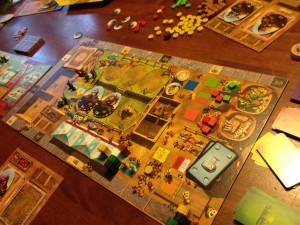 Dungeon Petz is by the same designer as Dungeon Lords and shares other traits like the same art style and same imp figures. However, Dungeon Petz is a totally separate game. During the game, players are trying to raise various strange creatures and score prestige points (PP) by having the best creatures in pet shows and by selling them too. Player with the most PPs at the end of 5 rounds wins.
Dungeon Petz is by the same designer as Dungeon Lords and shares other traits like the same art style and same imp figures. However, Dungeon Petz is a totally separate game. During the game, players are trying to raise various strange creatures and score prestige points (PP) by having the best creatures in pet shows and by selling them too. Player with the most PPs at the end of 5 rounds wins.
GAMEPLAY
Each player starts with a player board which has one basic cage on it and room for 3 more. Each round, players use their imps to get new pets, new cages, cage improvements, pet food, extra imps, as well as do a few other actions which I’ll mention later. The core mechanic for the game is worker placement as players use their imps to claim actions, but there is a nice twist to make it different to most worker placement games. In Dungeon Petz, players form their imps (and gold) into groups behind a screen. They then reveal their groups and the groups of the biggest size take their actions first. So, players can put all their imps in one basket so-to-speak to ensure they claim one action before anyone else, or they can put them in smaller groups to claim multiple actions but the smaller the group, the greater the risk that another player will have taken that action first. Read the rest of this entry »
Tags: board game news, Board Games, board gaming, Dungoen Petz
Posted in Board Game Review, Board Games, Dungeon Petz | No Comments »
Posted by James (admin) on 1st September 2012
K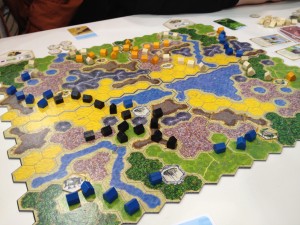 ingdom Builder is designed by the designer of Dominion and went on to win the coveted Spiel des Jahres award 2012. The game is relatively simple. Players score points at the end of the game based on where they have built their buildings based on criteria specified by 3 Kingdom Builder cards (randomly selected from 10). The board is created using 4 sections in any combination (randomly selected from 8).
ingdom Builder is designed by the designer of Dominion and went on to win the coveted Spiel des Jahres award 2012. The game is relatively simple. Players score points at the end of the game based on where they have built their buildings based on criteria specified by 3 Kingdom Builder cards (randomly selected from 10). The board is created using 4 sections in any combination (randomly selected from 8).
On their turn, a player has just one terrain card and they must place 3 of their buildings on unoccupied spaces on the board that match that terrain type. Buildings must be placed next to any of the player’s existing buildings, if possible; otherwise, they can be placed on any hexes of the matching terrain. If the player places any of their buildings next to one of the special locations on the board, they get to take one of the matching special action tiles.
As well as the mandatory action, players can use any special actions they have collected which allow a player to do things like moving buildings and building an extra buildings. The special actions can each be used once per turn. Read the rest of this entry »
Tags: board game news, Board Games, board gaming, Kingdom Builder, Spiel des Jahres
Posted in Board Game Review, Board Games, Kingdom Builder | No Comments »
 I wasn’t expecting much when Lords of Waterdeep was announced as Dungeons and Dragons-based board games have been pretty lack lustre in the past (the drab Castle Ravenloft being one). However, Lords of Waterdeep is very good with more of a eurogame at its heart.
I wasn’t expecting much when Lords of Waterdeep was announced as Dungeons and Dragons-based board games have been pretty lack lustre in the past (the drab Castle Ravenloft being one). However, Lords of Waterdeep is very good with more of a eurogame at its heart.



 There were a few wine-making games released a couple of years ago and I noticed a new intriguing one called
There were a few wine-making games released a couple of years ago and I noticed a new intriguing one called 


